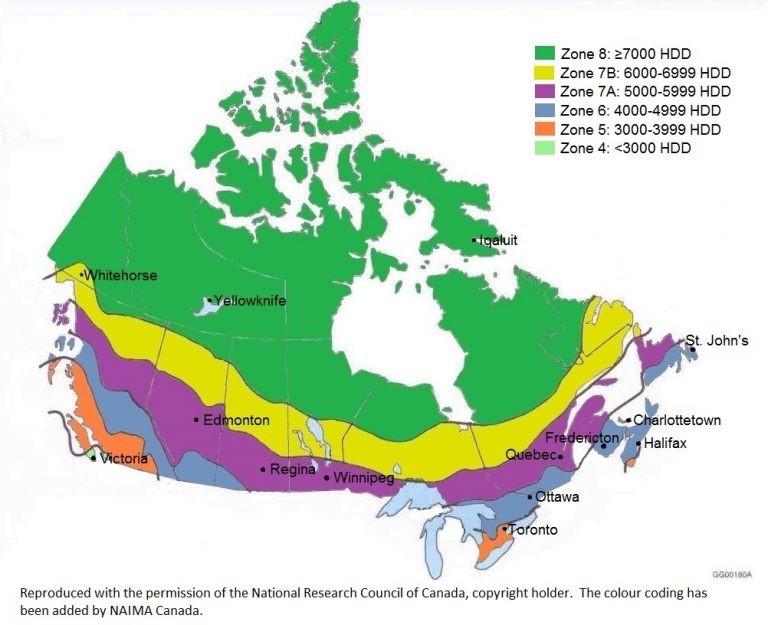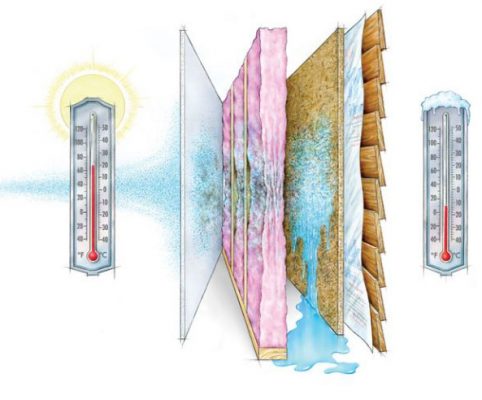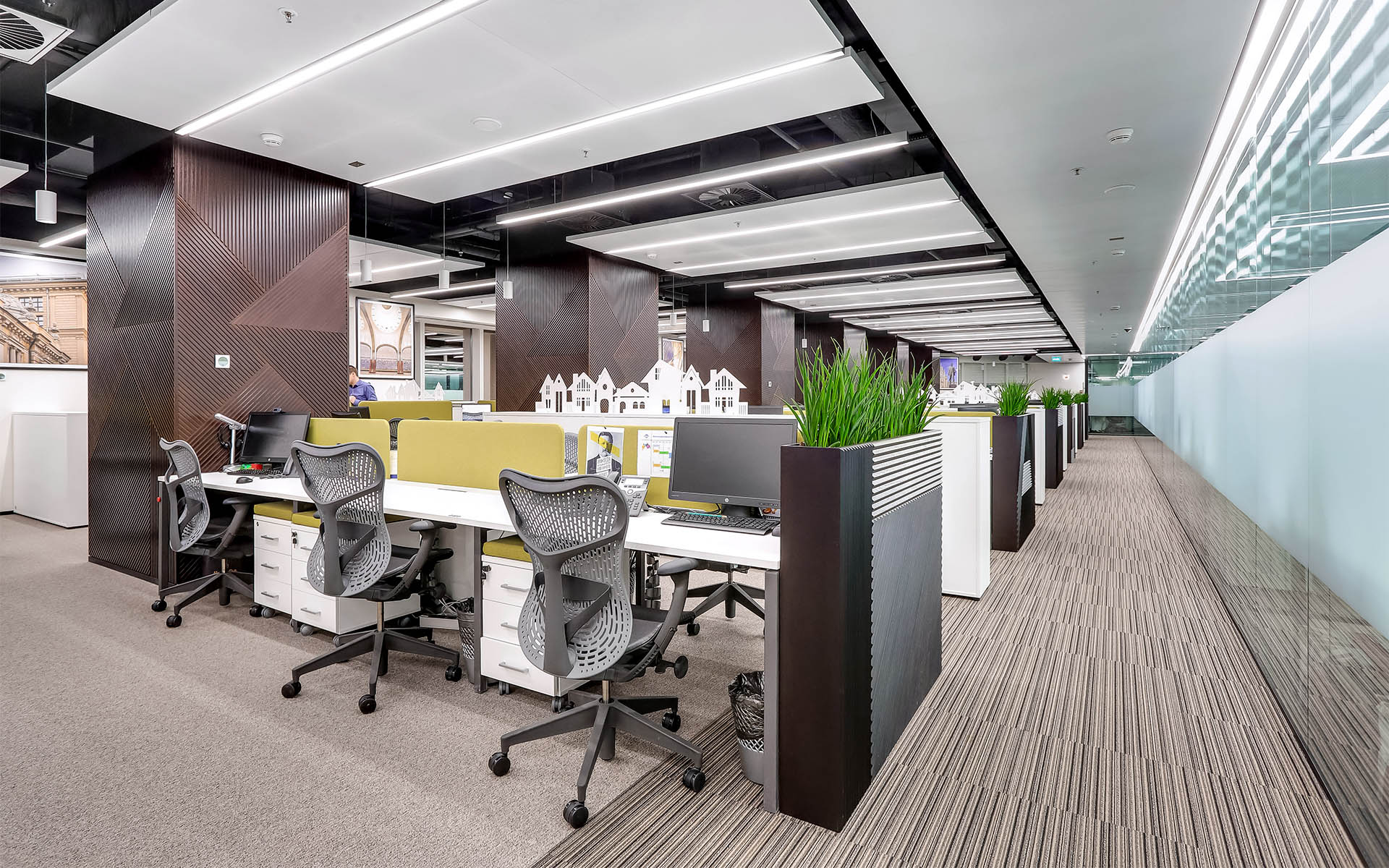Heat recovery ventilators (HRVs) are an important mechanical system in new and renovated buildings. In high performance buildings, they are critical. HRVs allow for a durable and healthy building. Let’s review the basics of HRVs, how they work and can be configured, and different types. Simply put, HRVs exchange polluted stale air with “fresh” outside air*. This process is not only good for occupant health but also for the health of the building, previously discussed in “Do Buildings Need to Breathe?”.
*While the outside air usually “fresher” than the indoor air, it still needs to be filtered of dust and particulate matter (think wild fire smoke – this requires a charcoal filter).
Ventilation without heat recovery
Before we look at HRVs lets briefly recognize that there are two other types of building ventilation systems that do not include heat recovery: exhaust-only and supply-only systems. An exhaust-only ventilation system relies on the exhaust fans in bathrooms, kitchens, and other areas where vial air contaminates should be exhausted for good source control. This was a common strategy in houses constructed in Canada until the codes started mandating HRVs about a decade ago. Ventilation systems that include no heat recovery pay large energy penalties as no heat is recovered, and an exhaust only system can impede on indoor air quality if there is no proper makeup air system. Most (like mine constructed 2008 in Winnipeg) simply relied on the natural air draw through a hole at the side of the house that dumped directly into the cold air return; not even a filter. Exhaust-only systems risk high negative indoor pressures that result in flue gasses in gas appliances back drafting into buildings, especially on very tight ones. Martin Holladay, a building scientist and senior editor at GreenBuildingAdvisor.com, pointed out the implications of back drafting in his blog entitled “Make Up Air for Range Hoods”, and how high cfm kitchen fans can lead to dangerous levels of indoor carbon monoxide levels. Recommending that “for most homes, 150 cfm to 250 cfm is plenty” for a kitchen fan (Holladay, Makeup Air for Range Hoods, 2010). Put into perspective, many residential kitchen fans are 400 to 800 cfm, and even up to 1200 cfm. In short, non HRV ventilation systems are not recommended in cold climates. However, in more temperate climates (ie southern United States) these systems can be a more attractive option due to their low cost. (Holladay, Are HRVs Cost Effective?, 2012).
Ventilation with heat recovery
There are generally two types of air exchange ventilators with heat recovery – active and passive. However, passive systems are extremely rare and uniquely engineered for each project.
Active HRVs
Active systems are typically referred to as a HRV (fan powered) in North America and, maybe more correctly descriptive, MVHR (mechanical ventilation with heat recovery) in Europe. They are both the same. They provide fresh air ventilation while transferring heat from the incoming to the outgoing, through the aide of mechanical fan power. Figure 1 illustrates the basic components of an HRV/MVHR. Note that the heat is transferred by conduction and the exhaust and intake airs do not mix.
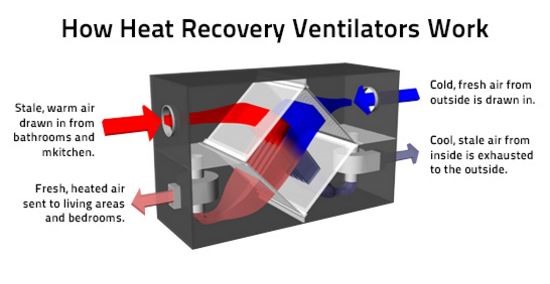
HRV’s do not provide any heating or cooling load, they simply reduce the energy penalty to provide fresh air ventilation, and therefore cannot replace a heating or cooling system. And to be clear, an “HRV” is not the same as “HVAC” (heating, ventilation, and air conditioning). An HVAC system is referring to all those items – the heating system, ventilation system, and air conditioning system. The required fan power to push the air, and the losses of energy from the outgoing warm air (as they are inherently less than 100% efficient), does mean that HRVs actually consume energy. However, their fan power is very small and their indoor temperature losses are a vital trade off to maintain healthy indoor air – critical for air tight homes. HRVs can recover up to five times more energy than it costs to operate when compared to non-heat transfer ventilation systems (Holladay, Are HRVs Cost Effective?, 2012). They can be fitting with an inline electrical heater to provide some auxiliary heat or to be regulated to the room temperature – since the supply air will always be cooler than the exhaust (in winter).
Just like a heating or cooling system, efficiency and control vastly differ from model to model. Some have heat transfer efficiency levels up to 90% and some have more sophisticated controls that can self adjust for the amount of ventilation based on factors such as indoor RH (relative humidity) or carbon dioxide levels. These more advanced controls are put in place to prevent over and under ventilating, causing an unnecessary energy or health penalty. HRVs are fitted with air filters to allow cleaner fresh air from entering, and some models offer HEPA or charcoal filters. Pricing range vastly from around $1000 to $6000+ for the HRV only. Like all mechanical systems, regular periodic maintenance is required that includes changing the air filter and cleaning the ducts and grilles.
Although HRV’s do not provide any heating or cooling capacity, there are a couple unique HRVs that incorporate heat pumps that does just that. The Pentacare-V12 by Minotair transfers heat energy from the exterior to the interior using a heat pump, Figure 2. Although this system is not able to solely replace a buildings heating and cooling system, except perhaps for a small super efficient house or small condominium, it may allow your primary heating and cooling system to be reduced in size and not need to operate during milder weather.
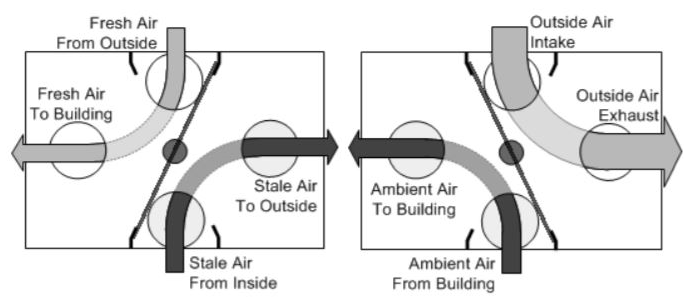
Passive HRVs
Passive heat recovery ventilation systems do not require any input power (to run the fans). These systems are very uncommon, however. A company in the United Kingdom, Ventive, have several PVHR (passive ventilation with heat recovery) products that works on the simple principals of stack effect (buoyancy of hot air rising, cool air falling) and wind pressures. The transfer of heat occurs from the outgoing warm air rising through a heat exchanger, and the cool outside air dropping down into the building, Figure 3. Ventive claim that their system has an efficiency of up to 94% heat recovery (“longer-term testing has shown 72% thermal efficiency is regularly achieved”), with no moving parts to maintain and no electricity costs (Ventive, n.d.). Their system is very unique as it may also be fitted in place of a dormant chimney in retrofit projects.

Ventilation layout
A typical layout of an HRV system in a house has the supply (fresh air) inlets in the living areas – living rooms and bedrooms, and the exhaust outlets in the kitchen, laundry, and bathrooms (Figure 4) for source control. Placing the HRV exhaust in the bathroom can eliminate the need for a typical direct bathroom exhaust, however it cannot replace a kitchen cooktop hood exhaust. This is due to the cooking oils and grease clogging up the HRV system. Good building practise recommends a minimum 2m horizontal clearance between the kitchen HRV exhaust and the cooktop for this reason. Early high-performance homes typically placed a recirculating charcoal filter exhaust fan above the cooktop to mitigate the energy penalty of directly venting the exhaust air outdoors. Now, however, through many studies its generally accepted within the high-performance building community that the best solution is to exhaust the air out – accepting a minor energy penalty for much improved indoor air quality.

. Note the HRV placement in the attic. This should only be done if the attic is a conditioned space, part of the house, not if it is vented. Additionally, ducts should only be installed within the conditioned envelope.
An HRV can be connected to the heating and cooling air distribution system, or run separately. There are advantages and disadvantages to both configurations which are largely dependant on the building type and layout. Typically, the most cost effective (and space saving) solution is to connect the HRV supply to the forced air ductwork. However, it is advantageous from a performance point of view to run the HRV system independently from the heating and air conditioning system. This is because ventilation demands differ from heating and cooling needs.
As with all HVAC components, the HRV and ducts should be installed within the conditioned space, that is, inside of the building envelope, and not in places like vented crawlspaces or attics. If this is not possible, then every part of the system must be insulated and carefully air sealed. In any case, the two ducts connecting the HRV to the outdoors must be appropriately insulated and run as short as possible.
HRV vs ERV
Another type of HRV is an ERV (energy recovery ventilator). An ERV recovers heat the same as an HRV, but it also recovers moisture (Figure 5). Their downside is that their efficiencies to recover heat is less than an equivalent sized HRV. Generally, ERV’s are beneficial in most single-family homes, but every situation is unique and should be evaluated. ERV’s shine in warm humid and arid cold climates as they limit moisture movement across the building envelope.

Last words
As we build tighter and tighter buildings, HRV’s and ERV’s become increasingly more critical. They are an invaluable mechanical system to ensure a long-lasting healthy building, while minimizing energy loads. They can provide balanced fresh air more evenly throughout a space, leading to better comfort, than exhaust or supply-only ventilation systems. Those that have an HRV, use it, especially in winter, and understand how to operate it and change its filters. Do not turn it off in winter to save a few dollars a month. Your health, and the health of your building are worth magnitudes more.
Lastly, to rip off the band aid. If your building, new or major renovation, budget for a higher performing HRV/ERV – a good number is $15,000. The intent is not to check a box to satisfy code with a budget system. Higher performing systems have extremely low energy ECM fans that have life expectancies greater than several decades, self balancing fans for balanced air flow, heat exchanger core efficiencies in the 80-90% range, automatic core bypass (when evening temperatures are favorable to bypass the core to provide nighttime cooling), integral pre and post heaters, and full phone app controlled.
References
- Holladay, M. (2010, November 19). Makeup Air for Range Hoods. Retrieved from Green Building Advisor
- Holladay, M. (2012, December 7). Are HRVs Cost Effective? Retrieved from Green Building Advisor
- Minotair. (n.d.). Why Ventilate? Retrieved from Minotair The Science of Air
- Primex Fits. (2014, May 8). Why a HRV / ERV Ventilation System is a Smart Investment. Retrieved from Primex Fit everything. Together
- Sustainable Homes Ireland. (n.d.). Heat Recovery Ventilation. Retrieved from Sustainable Homes Ireland
- Venmar. (2017, January). HRV and ERV – Why Choose a ERV. Retrieved from Venmar, Clean Air Living
- Ventive. (n.d.). Ventive the future of ventilation. Retrieved from

